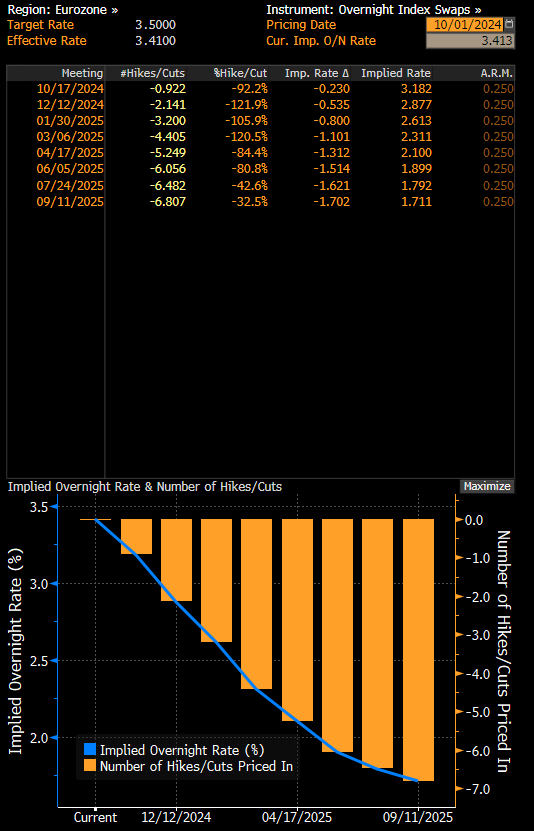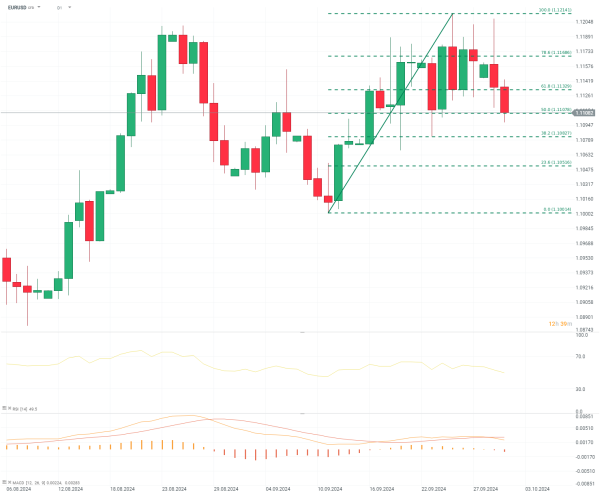Chart of the Day - EURUSD (01.10.2024)
The EUR/USD pair has experienced significant volatility today, with the euro strengthening against the dollar despite mixed economic data. This comes amidst a complex backdrop of Eurozone inflation figures, manufacturing PMI data, and shifting monetary policy expectations. The currency pair is currently trading around 1.11, down 0.23% on the day.
EUR/USD's resilience comes despite the Eurozone's inflation dropping below the European Central Bank's 2% target for the first time in three years. The flash CPI reading for September came in at 1.8% year-on-year, down from 2.2% in August. This decline in inflation has fueled market expectations for potential rate cuts by the ECB, with traders now pricing in a high probability of a 25 basis point cut in October.
The U.S. Dollar's performance has been a key factor influencing the pair. The Dollar Index (DXY) is currently struggling to maintain its recent gains, pressured by the increasing likelihood of Federal Reserve rate cuts following last week's cooler-than-expected PCE inflation data. The core Personal Consumption Expenditures (PCE) Price Index, the Federal Reserve's preferred inflation gauge, increased by 2.7% year-on-year in August, moving closer to the central bank's 2% target.

Source: Bloomberg Financial LP
This inflation data, coupled with today's Eurozone figures, has fueled market expectations for significant rate cuts by both the ECB and the Federal Reserve. Currently, traders are pricing in a high probability of a 25 basis point rate cut by the ECB in October, while expectations for Fed rate cuts have also increased. These expectations for looser monetary policy on both sides of the Atlantic have contributed to the EUR/USD pair's recent volatility.
Adding to the complex market picture are the mixed manufacturing PMI data from the Eurozone. While the overall Eurozone manufacturing PMI improved slightly to 45.0, it remains in contraction territory. Spain's strong performance (53.0) was offset by continued weakness in Germany (40.6), highlighting the divergent economic conditions within the currency bloc.
For traders and investors, key factors to watch in the coming days include:
- The U.S. ISM Manufacturing data due later today, which could influence Fed policy expectations.
- ECB officials' comments, particularly following Governing Council member Olli Rehn's suggestion of "more grounds for cutting rates at the October meeting."
- This week's U.S. employment data, including ADP figures and the crucial Nonfarm Payrolls report.
- Any further developments in Eurozone economic indicators, especially those related to inflation and growth.
- The impact of global geopolitical tensions on risk sentiment and safe-haven flows.
EUR/USD prices are likely to remain sensitive to these developments, as well as to any shifts in ECB and Federal Reserve policy expectations. The pair's recent movement has pushed it towards key technical levels, with resistance around the 50% Fibonacci retracement level. However, the overall trend remains uncertain, supported by diverging economic data and central bank policy expectations between the Eurozone and the United States.
EURUSD (D1 interval)
EUR/USD is trading 0.2% lower today and is down 0.92% from recent highs. It has breached the 61.8% Fibonacci retracement level and is now above the 50% Fibonacci retracement, which will act as resistance and support, respectively, for today's session. Over the past two weeks, the RSI has been in bearish divergence, forming lower highs and lower lows. The MACD issued a sell signal yesterday, further strengthening the bearish outlook. The 38.2% Fibonacci retracement level at 1.0827 could be tested. For bulls to regain control, US data later today must come in much weaker than expected, potentially fueling bets for a dovish Fed.

Source: xStation